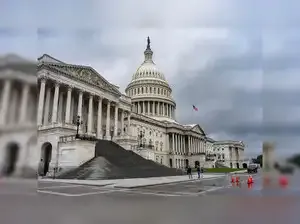US government shutdown hits Day 35, debt explodes $17 billion daily. The federal government remains partially closed. Hundreds of thousands of workers are furloughed or working without pay. Services slow. Permits, inspections, and federal programs stall. Families feel the pinch as paychecks are delayed. Small businesses dependent on government contracts are also impacted.
The national debt has crossed $38 trillion, growing at the fastest pace outside the pandemic era. Every day of gridlock adds billions in lost output and borrowing costs. Economic activity slows. Tax revenues dip. The government may need to borrow more just to keep operations afloat.
Past shutdowns give context. The 35-day closure in 2018–19 cost at least $11 billion and shaved GDP growth by 0.2%. The current shutdown is on track to match or exceed that record. Prolonged uncertainty affects consumer confidence, business investment, and market stability.
Federal employees are caught in the middle. Some are furloughed, others work without immediate pay. Stress rises as bills pile up. Communities feel it too—public services are delayed. People waiting on federal assistance or programs face uncertainty.
Every day, the shutdown bleeds the economy. Contractors lose revenue. Local businesses see reduced spending. Government projects are paused or canceled. The compounding impact grows as each day adds billions to the national cost.
The political standoff continues. Lawmakers debate not just funding but also policy issues. Health care subsidies, border security, and foreign aid are sticking points. Delays in passing a budget make the shutdown longer and more costly. Public pressure is mounting, but compromise remains elusive.
Markets are watching closely. Investor confidence wavers. Longer shutdowns can raise borrowing costs for the U.S. and reduce trust in fiscal stability. Rating agencies may issue warnings. International investors take note as debt grows unchecked.
The shutdown’s human cost is immediate. Families, contractors, and communities struggle with delayed pay, stalled services, and economic uncertainty. The ripple effect touches all levels—from federal employees to small-town businesses. Every day matters, and every decision has consequences.
Experts warn that prolonged gridlock will have long-term effects. Economic scarring can reduce growth, weaken spending, and slow recovery. The cost is not just financial; it’s social and psychological. Confidence in government efficiency takes a hit, making future governance harder.
The key numbers to track: the number of days without a budget, daily economic losses, furloughed and unpaid federal workers, rising national debt, and stalled government programs. Each figure tells the story of how severe this shutdown has become.
In summary, the US government shutdown is more than a political fight. It’s a full-scale economic and social event. Debt is soaring, federal workers are unpaid, services are stalled, and the economy is bleeding billions each day. How long it lasts will define the economic and human cost for months to come.
As the days pass, this shutdown is creeping toward record territory. If no agreement is reached soon, it could rival the longest shutdown in U.S. history. The standoff is not just about numbers—it’s about policy disagreements, including health insurance subsidies, border security, and foreign aid.
Federal employees are caught in the middle. Some are furloughed, meaning they don’t work and don’t get paid. Others continue to work but without immediate pay, creating stress for families who rely on steady income. Everyday government services—from permitting to inspections—are also slowing down or halting entirely.
The shutdown highlights how political gridlock can directly affect ordinary people. It’s not just politicians arguing—it’s communities, small businesses, and public services feeling the pressure every day.
A shutdown slows down government efficiency, but it doesn’t stop debt growth. Programs that are delayed can become more expensive later. Economic activity slows, tax revenue dips, and the government may need to borrow more just to keep up.
Some reports suggest the cost per day of this shutdown could be tens of billions of dollars when you account for lost productivity, delayed spending, and the rising debt. Even if exact numbers vary, the financial impact is massive and felt immediately in many sectors of the economy.
In short, the shutdown isn’t just a temporary pause—it’s a financial strain that could have long-term consequences for the economy, government budgets, and even taxpayers’ wallets.
The broader economic impact is serious. When government employees don’t spend, local businesses suffer. When permitting, inspections, or other federal services slow down, it can delay projects, halt construction, and reduce growth. Even contractors and service providers dependent on government work are affected.
Past shutdowns provide context: during the 35-day shutdown in 2018–19, the U.S. economy lost at least $11 billion, and GDP growth slowed. While the current numbers are still unfolding, economists warn that prolonged uncertainty can have ripple effects across the economy.
In short, every day the shutdown continues, the financial strain grows exponentially. Lost wages, delayed payments, and slowed government activity combine to create a cascading impact that affects millions of Americans.
If the current shutdown continues, it could match or surpass previous records, making it one of the longest in history. This isn’t just a political headline; it’s a real measure of how long government services and federal operations can remain disrupted.
Historically, long shutdowns create long-lasting impacts. Beyond lost wages, they can affect consumer confidence, delay government projects, and strain local economies. Businesses adjust cautiously, families tighten spending, and public sentiment can turn sharply against policymakers.
Understanding the historical context helps frame the stakes: this isn’t just about politics—it’s about the real-world consequences for citizens and the economy if the shutdown continues.
Services for citizens may be interrupted. From delayed social safety nets to postponed permits, everyday life feels the effects. The longer the delay, the harder it is to catch up once the government reopens.
There’s also a broader impact on confidence. Investors, businesses, and consumers can lose faith in the government’s ability to manage finances, which could raise borrowing costs and affect markets. Political risks increase as public opinion shifts, potentially influencing elections and future policy.
In short, a prolonged shutdown creates economic scarring—a long-lasting effect that goes beyond immediate losses. The sooner lawmakers reach a solution, the sooner the economy and citizens can recover.
The national debt has crossed $38 trillion, growing at the fastest pace outside the pandemic era. Every day of gridlock adds billions in lost output and borrowing costs. Economic activity slows. Tax revenues dip. The government may need to borrow more just to keep operations afloat.
Past shutdowns give context. The 35-day closure in 2018–19 cost at least $11 billion and shaved GDP growth by 0.2%. The current shutdown is on track to match or exceed that record. Prolonged uncertainty affects consumer confidence, business investment, and market stability.
Federal employees are caught in the middle. Some are furloughed, others work without immediate pay. Stress rises as bills pile up. Communities feel it too—public services are delayed. People waiting on federal assistance or programs face uncertainty.
Every day, the shutdown bleeds the economy. Contractors lose revenue. Local businesses see reduced spending. Government projects are paused or canceled. The compounding impact grows as each day adds billions to the national cost.
The political standoff continues. Lawmakers debate not just funding but also policy issues. Health care subsidies, border security, and foreign aid are sticking points. Delays in passing a budget make the shutdown longer and more costly. Public pressure is mounting, but compromise remains elusive.
Markets are watching closely. Investor confidence wavers. Longer shutdowns can raise borrowing costs for the U.S. and reduce trust in fiscal stability. Rating agencies may issue warnings. International investors take note as debt grows unchecked.
The shutdown’s human cost is immediate. Families, contractors, and communities struggle with delayed pay, stalled services, and economic uncertainty. The ripple effect touches all levels—from federal employees to small-town businesses. Every day matters, and every decision has consequences.
Experts warn that prolonged gridlock will have long-term effects. Economic scarring can reduce growth, weaken spending, and slow recovery. The cost is not just financial; it’s social and psychological. Confidence in government efficiency takes a hit, making future governance harder.
The key numbers to track: the number of days without a budget, daily economic losses, furloughed and unpaid federal workers, rising national debt, and stalled government programs. Each figure tells the story of how severe this shutdown has become.
In summary, the US government shutdown is more than a political fight. It’s a full-scale economic and social event. Debt is soaring, federal workers are unpaid, services are stalled, and the economy is bleeding billions each day. How long it lasts will define the economic and human cost for months to come.
What is happening with the government shutdown?
The U.S. federal government entered a shutdown on October 1, 2025, after Congress failed to pass a budget for the new fiscal year. This means many government operations are paused, funding is temporarily unavailable, and hundreds of thousands of federal workers are affected.As the days pass, this shutdown is creeping toward record territory. If no agreement is reached soon, it could rival the longest shutdown in U.S. history. The standoff is not just about numbers—it’s about policy disagreements, including health insurance subsidies, border security, and foreign aid.
Federal employees are caught in the middle. Some are furloughed, meaning they don’t work and don’t get paid. Others continue to work but without immediate pay, creating stress for families who rely on steady income. Everyday government services—from permitting to inspections—are also slowing down or halting entirely.
The shutdown highlights how political gridlock can directly affect ordinary people. It’s not just politicians arguing—it’s communities, small businesses, and public services feeling the pressure every day.
Why is the national debt exploding right now?
During this shutdown, the U.S. national debt has soared past $38 trillion. That’s a staggering number, but it helps to understand what it really means. The government still has expenses to cover, even if it’s partially shut down, and borrowing costs continue to rise.A shutdown slows down government efficiency, but it doesn’t stop debt growth. Programs that are delayed can become more expensive later. Economic activity slows, tax revenue dips, and the government may need to borrow more just to keep up.
Some reports suggest the cost per day of this shutdown could be tens of billions of dollars when you account for lost productivity, delayed spending, and the rising debt. Even if exact numbers vary, the financial impact is massive and felt immediately in many sectors of the economy.
In short, the shutdown isn’t just a temporary pause—it’s a financial strain that could have long-term consequences for the economy, government budgets, and even taxpayers’ wallets.
How much is the economy losing every day?
The daily cost of the shutdown is significant. Hundreds of thousands of federal workers are either furloughed or working without pay. Estimates suggest billions of dollars in lost output accumulate each week. Families feel it when paychecks are delayed, and small businesses feel it when federal contracts or programs stall.The broader economic impact is serious. When government employees don’t spend, local businesses suffer. When permitting, inspections, or other federal services slow down, it can delay projects, halt construction, and reduce growth. Even contractors and service providers dependent on government work are affected.
Past shutdowns provide context: during the 35-day shutdown in 2018–19, the U.S. economy lost at least $11 billion, and GDP growth slowed. While the current numbers are still unfolding, economists warn that prolonged uncertainty can have ripple effects across the economy.
In short, every day the shutdown continues, the financial strain grows exponentially. Lost wages, delayed payments, and slowed government activity combine to create a cascading impact that affects millions of Americans.
How does this shutdown compare historically?
Government shutdowns have happened before, but few have been this long. The longest shutdown on record lasted 35 days from December 2018 to January 2019. Other major shutdowns lasted 22 days and 16 days, showing that long funding gaps are rare but not unprecedented.If the current shutdown continues, it could match or surpass previous records, making it one of the longest in history. This isn’t just a political headline; it’s a real measure of how long government services and federal operations can remain disrupted.
Historically, long shutdowns create long-lasting impacts. Beyond lost wages, they can affect consumer confidence, delay government projects, and strain local economies. Businesses adjust cautiously, families tighten spending, and public sentiment can turn sharply against policymakers.
Understanding the historical context helps frame the stakes: this isn’t just about politics—it’s about the real-world consequences for citizens and the economy if the shutdown continues.
What happens if the shutdown drags on?
The longer the shutdown continues, the more expensive and damaging it becomes. Costs pile up daily, including lost productivity, delayed payments, and rising borrowing costs. Every day without a budget is a day the economy slows down.Services for citizens may be interrupted. From delayed social safety nets to postponed permits, everyday life feels the effects. The longer the delay, the harder it is to catch up once the government reopens.
There’s also a broader impact on confidence. Investors, businesses, and consumers can lose faith in the government’s ability to manage finances, which could raise borrowing costs and affect markets. Political risks increase as public opinion shifts, potentially influencing elections and future policy.
In short, a prolonged shutdown creates economic scarring—a long-lasting effect that goes beyond immediate losses. The sooner lawmakers reach a solution, the sooner the economy and citizens can recover.
What should we track in the coming days?
There are several key numbers and indicators to watch:- Duration: How many days until a funding agreement is reached?
- Federal employees: How many remain unpaid or furloughed?
- Economic impact: What’s the daily and weekly cost in lost output and productivity?
- National debt: How fast is it climbing during this shutdown?
- Policy decisions: Are lawmakers adding major provisions, or is it a clean stop-gap?





